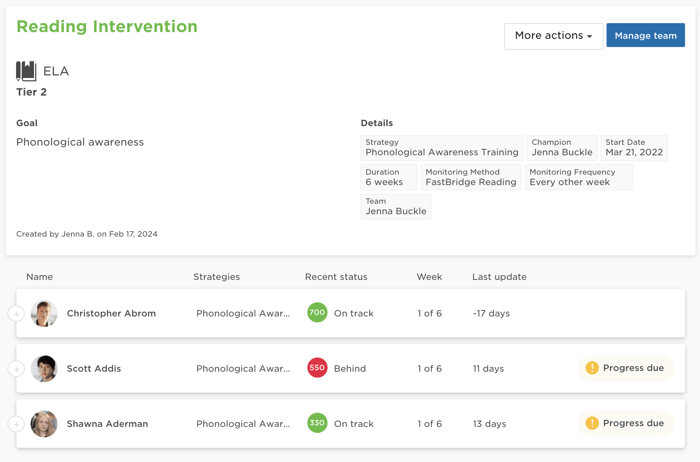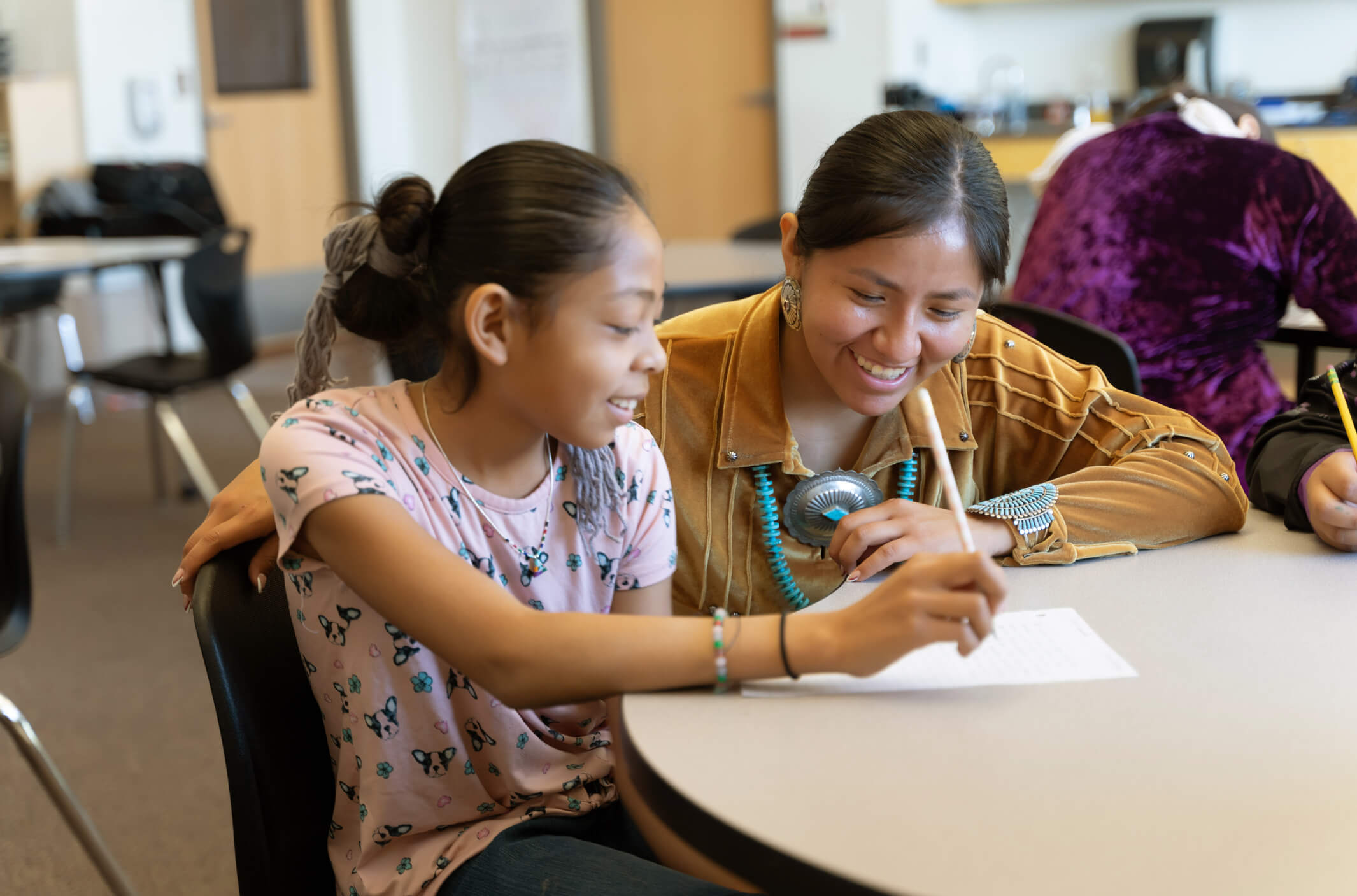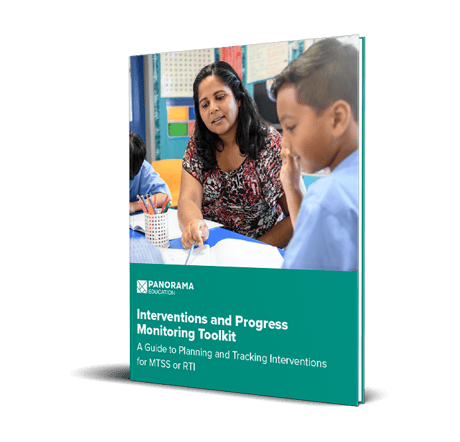Small-group interventions can be an effective way to differentiate supports for learners who are in need of extra instructional time in a specific area.
First, what is small-group instruction? Typically, educators or interventionists deliver this type of instruction with groups of three or more students within a tiered Response to Intervention (RTI) or Multi-Tiered System of Supports (MTSS) model. Assessment data can help identify students who generally need the same level of support in a particular area, such as reading, mathematics, or life skills.
With small-group instruction, it can be helpful for your school or district team to build a shared intervention menu of high-quality strategies that are effective in groups.
In this article, explore a curated list of small-group interventions organized by subject-area (e.g., Reading, Math, and SEL/Behavior). We also indicate recommended Tiers (e.g., Tier 3) and grade-level appropriateness (e.g., elementary school, middle school, and/or high school).
As a bonus, we've included group intervention planning forms that can help your team monitor and document students' progress toward mastery over the course of the intervention program.
Table of Contents
Small-Group Reading Interventions
Small-Group Math Interventions
Small-Group Behavior Interventions
Group Intervention Planning Forms
|
Key Takeaways:
|
Small-Group Reading Interventions
Intensive small-group reading interventions can help students work to master the five core elements of reading: phonological awareness, phonics, reading fluency, vocabulary, and comprehension. Research shows that reading intervention provided in small groups is more effective if targeted at specific reading skills. The menu below offers evidence-based group reading interventions for ELL students and readers in need of additional support towards mastery.
| Intervention Name | Tier(s) | Grade Level(s) | Intervention Description |
|
Close Reading |
1, 2, 3 | K-12 |
Close Reading is a strategy for complex texts that develops students’ understanding through multiple opportunities to read the same text. Each time a student reads through the short, complex text, the level of thinking deepens, allowing the student to grasp the reading better each time. How it works: (Planning) Choose a short, complex text. Identify the learning objective of the lesson. Identify areas of complexity in the text and determine how to best chunk the text for meaning. Script questions. (First Reading) Key ideas and details. Explain the purpose of the lesson to students. Students read and annotate for meaning. (Second Reading) Craft and structure. Ask the questions on your script to deepen students' understanding of the text. |
| 1, 2, 3 | K-3 |
Practice applying word attack skills with students to improve their reading rate and accuracy. Note: This intervention requires phonological awareness. Use a phonological awareness assessment to determine whether or not your student already has these skills. How it works: (1) Segmenting and Blending Practice: Students tap each letter making each sound in a word, then blend them together. (2) For longer words, teach students to use their fingers to mask words and word parts. This makes decoding multi-sensory and helps visually segment words into smaller pieces. |
|
|
Graphic Organizer |
1, 2, 3 | 2-12 |
Graphic organizers are designed to visually represent thinking and to visually connect key ideas. Graphic organizers can serve many purposes for students, from helping them take notes in class, to recording different perspectives during a group discussion, to pre-writing, problem-solving, pre-reading, or synthesizing their thinking at the end of a lesson. How it works: (1) Select an organizer that matches the task. (2) Model how to use the organizer. (3) Consider collecting the graphic organizers at the end of the lesson to give students feedback. |
| 2, 3 | K-3 |
Teach students to recognize and manipulate the sounds in words. This can involve detecting, deleting, segmenting, or blending segments of spoken words (i.e., words, syllables, onsets and rimes, phonemes) or identifying and producing rhymes or alliteration. How it works: (1) Teach students that words can be broken into smaller parts. Demonstrate how to isolate the individual sounds in words and how to break words into their component sounds by modeling with two- or three-phoneme words sun as "dig," "sun," or "at." (2) Lead students in practicing isolating the sounds in words by using Elkonin sound boxes or colored discs to mark the unique sounds they hear in words. |
|
| 2, 3 | 5-12 |
Repeated reading is an academic practice that aims to increase oral reading fluency. Repeated reading can be used with students who have developed initial word reading skills but demonstrate inadequate reading fluency for their grade level. During repeated reading, a student sits in a quiet location with a teacher and reads a passage aloud at least three times. Typically, the teacher selects a passage of about 50 to 200 words in length. If the student misreads a word or hesitates for longer than five seconds, the teacher reads the word aloud, and the student repeats the word correctly. If the student requests help with a word, the teacher reads the word aloud or provides the definition. The student rereads the passage until he or she achieves a satisfactory fluency level. |
Small-Group Math Interventions
Within the RTI framework, small-group instruction is used much less frequently for math than for reading. However, there is a growing body of research on the effectiveness of mathematics interventions, according to practice guide from the What Works Clearinghouse prepared for the National Center for Education Evaluation and Regional Assistance. Here are a few math strategies that are appropriate for use in group intervention settings.
| Intervention Name | Tier(s) | Grade Level(s) | Intervention Description |
|
Word Problem Types |
2, 3 | K-5 | Teach students to recognize various problem types and determine an appropriate problem solving strategy based on the problem type. The student reads the problem, restates the problem in their own words, visually represents the problem, creates a plan to solve the problem, computes the answer, and then checks their work. |
| 1, 2 | K-8 |
Fluent understanding of the relationships between numbers is critical for problem solving. Build student number sense through "number talks," teaching fact families, and strategies like "counting on" and "make 10." |
|
|
Math Time Drill |
1, 2 | K-12 |
Timed math drills are used to improve students' speed and ease of math fact recall. The goal of math drills is to build students' automaticity, allowing them to instantly recall the answer to any math fact, freeing up cognitive energy to solve more complex problems. How it works: (1) Pass out drill sheets face down. (2) Set the timer for three minutes. (3) Students answer as many questions as they can. (4) Lead students in correcting their work. |
| 2 | K-8 |
Teach students a conceptual understanding of place value using manipulatives, like base 10 blocks. This helps to introduce and build number sense skills. |
Small-Group Behavior Interventions
Although academic-based interventions have existed for years, small-group behavior interventions are an emerging practice. For example, interventionists or behavior coaches might gather a group of students who need support in similar core life skills (e.g., emotion regulation or relationship skills) during lunch time or an advisory period. Gathering student perception data can help identify which students might benefit from these types of small-group interventions.
The small-group interventions listed below are sourced from leading curriculum partners and are available in Panorama's Playbook, an online professional learning library for our school and district partners.
| Intervention Name | Tier(s) | Grade Level(s) | Intervention Description |
| 1, 2 | PK-12 | Greet students intentionally at the door using protocols such as "Eye to Eye" and "Name to Name." | |
|
Asking For Help |
2 | K-12 |
Help students identify areas in their lives in which they could use support and construct an explicit request for support. For example, ask students to identify a problem they could use help on right now and someone who might be able to help. Or, ask students to craft a written request for help. |
| 2 | K-12 |
Use this move to connect with your students beyond the classroom material and build stronger relationships. Have students fill out a survey that pulls out things they are interested in and/or passionate about. |
|
|
Empathy Exercise |
1, 2 | 6-12 |
Encourage students to be more empathetic and increase perceptions of “connectedness” in your classroom using a short self-reflection questionnaire. |
| 2, 3 | K-12 |
A "Lunch Bunch" is a small group of students who meet with a teacher or counselor away from their usual lunch place. For teachers, it’s an important time to build connections and learn about students. For counselors, it's a space to work towards a specific goal. Goals and duration vary from group to group. |
|
|
Make a Face |
1, 2 | PK-5 |
Children learn a simple way to “make change.” By changing their facial expression, they can change how they’re feeling and acting and, by extension, how others experience them. |
| 1, 2 | K-12 |
Helps students reframe negative thoughts and turn them into productive energy. |
|
| 1, 2 | K-12 |
Students name a "rose," a "bud," and a "thorn" to identify positive moments and areas where they need support. |
|
| 1, 2 | K-5 |
The goal of this intervention is to take stock of where everyone in your community is at during the start or end of class, or during a community circle. It is a simple yet powerful exercise that enhances emotional awareness, promotes authenticity, and builds community. |
|
| 1, 2 | K-12 |
WOOP stands for Wish, Outcome, Obstacle, and Plan. WOOP helps you to explore what your wish is as well as the barriers that hold you back from fulfilling this desire. |
If you use Panorama: You can easily build and track group intervention plans across reading, math, and behavior. Select students from your roster to include in the group, then assign an intervention from Panorama's intervention library. Add progress monitoring notes for each student as the plan progresses.
 Example of a group intervention plan in Panorama (mock data pictured)
Example of a group intervention plan in Panorama (mock data pictured)
Group Intervention Planning Forms
For small-group instruction to be most effective, it's critical to log and document results (also known as progress monitoring). How are students in the group performing against the intervention goal? Is the intervention working?
Once you and/or your grade-level team identify students who need the same targeted intervention, use the planning sheets/forms below. The first form is best for creating the initial small-group intervention plan. The second form is best for recording students' progress as the intervention continues. You can also download these forms in PDF and Excel formats in this toolkit.
|
|
|
Frequently Asked Questions: 1. How do small-group interventions fit into our existing Response to Intervention (RTI) or Multi-Tiered System of Supports (MTSS) framework? Small-group interventions are a key component of RTI/MTSS, providing targeted support to students who require additional instruction in specific areas. These interventions are typically delivered within Tier 2 or Tier 3 of the framework, based on students' needs and progress monitoring data. 2. What criteria should we consider when selecting small-group intervention strategies for our district? When selecting intervention strategies, consider evidence-based practices supported by research. Additionally, assess the alignment of interventions with students' needs, the availability of resources and materials, and the capacity of educators to implement the interventions effectively. 3. What role do progress monitoring and data analysis play in the effectiveness of small-group interventions? Progress monitoring and data analysis are critical components of small-group interventions. Regularly assessing students' progress allows educators to adjust instruction, modify interventions, and make data-informed decisions. Analyzing data enables educators to identify trends, patterns, and areas for improvement, ultimately maximizing the effectiveness of interventions. 4. How can district leaders support educators in implementing and sustaining small-group interventions effectively? District leaders can support educators by providing professional development, coaching, and resources tailored to the needs of small-group instruction. This may include offering training on evidence-based practices, facilitating collaboration among educators, and allocating funding for intervention materials and staffing. Additionally, fostering a culture of continuous improvement and accountability can help sustain the implementation of small-group interventions over time. |







